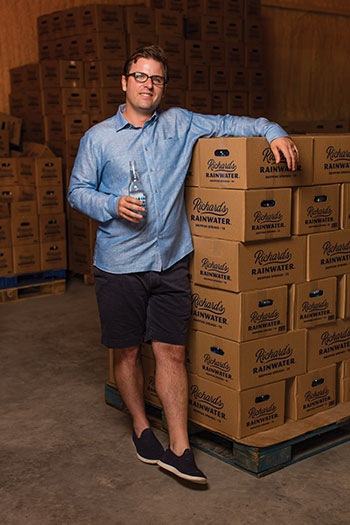Sparkling and Sustainable

Richard’s Rainwater has two things on its agenda: bring delight to consumers while saving the world’s water crisis.
In 1994, options for water in Dripping Springs were limited. The well water was hard and city water did not taste great. Richard Heinichen knew there needed to be both a clean and sustainable water source.
After installing a whole-house collection system in his own home in 1994, Heinichen began his quest to bring the joy of rainwater to those around him. He went on to install over 1,000 collection systems for private and commercial use through Tank Town, a collection tank company, and bottled the “cloud juice” he collected for consumers on the go.
Getting permission and permits to bottle rainwater without using a chemical-free process to purify the water, was a looming feat, however. Texas legislators had to devote a considerable amount of time defining when and how rainwater can be collected in order to ensure water quality standards, water rights, and public health concerns.

In 2002 Richard’s Rainwater was finally approved and founded, becoming the first public water supply to receive approval from the FDA and Texas Commission on Environmental
Quality to bottle and sell filtered rainwater to the public. Furthermore he received approval to purify the water using a chemical-free process called ozonation. More recently, the brand updated its packaging and renamed its sparkling rainwater from Happy Water, to Richard’s Sparkling Rainwater.
How it’s made
Many water companies source from municipal water which is supplied by lakes, rivers, wells, and reservoirs. Richard’s Rainwater starts straight from the source. Captured right from the sky, the water is free of any natural or manmade contaminants, and the process of purifying the water produces practically zero waste.
The water falls into fiberglass tanks and is pumped from one tank to another through ultraviolet light to kill any bacteria. The water then goes through a process called reverse osmosis. Pressure is applied to rainwater to pass through a membrane to the lower concentrated solution (purified rainwater), leaving a higher concentration of solute (natural minerals or debris) on one side, and only solvent (really pure rainwater) on the other. From there it goes through ozone sanitization, which replaces the need for chlorine as a disinfectant. Ozonation is the method of pumping 03, a colorless gas, into the tanks. Ozonation has a greater disinfection effectiveness against bacteria and viruses compared to chlorination. The only thing purer than rainwater is distilled water.
How it’s carbonated
The only way to make bottled rainwater more fulfilling is by adding bubbles, which also happens to be a scientific feat. Carbonating rainwater is near impossible since carbon dioxide binds best to water with impurities.
The bubbling of the rainwater takes places at nucleation site, a preexisting microscopic gas pocket where bubbles can form that is found in debris or dirt in the water.
Using ice-cold temperatures—since water at 32 degrees can hold five times more carbon dioxide than water at 140 degrees—and the right amount of pressure, carbonated “cloud juice” is created. Heinichen’s carbonation process is also patent pending.
.jpg)
Sustainability in the future
The closed system captures 550 gallons of drinking water for every one inch of rain and 1,000 square feet of collection area.
“We think rainwater is the most sustainable source of drinking water on the planet,”says Richard’s Rainwater CEO, Taylor O’Neil. “We want to capture the water before it is contaminated.”
Other processes produce a substantial amount of waste, require more energy to process the water, or require chemicals to clean the water. When it comes to business sustainability, Richard’s Rainwater has never needed to make tradeoffs on profits, people, or the planet.
O’Neil is aiming to be the most sustainable bottled water company in the world, planning to donate a portion of their profits to charities who are working toward solving the global water crisis. By next year, the company plans to have a zero-energy facility by using solar panels, limit the amount of emissions from transport by delivering straight to doors in certain areas, and make its packaging eco-friendly.
“There is a lot of great marketing out there,” O’Neil says. “But very few differentiated [bottled water] products—we know we have one of them.”






